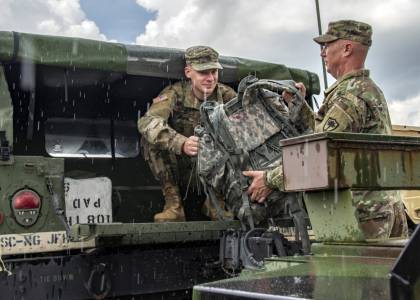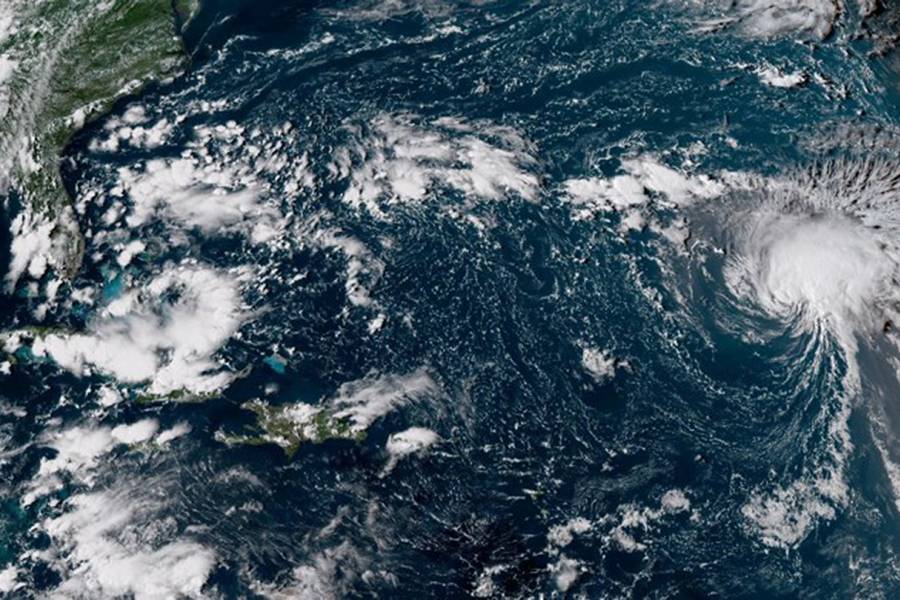When Hurricane Florence reaches the U.S., it's expected to bring with it up to 30 inches of rain and a storm surge that could put parts of the Carolinas under as much as 13 feet of floodwater. If the storm stays on course, its effects will be largely focused in two southern states that are home to more than 2,700 structurally deficient bridges, 1,400 dams with high hazard potential, and 1,600 miles of inland waterways deluged with stormwater—and nowhere for it to go.
Nationwide, infrastructure is failing. For 2017, the American Society of Civil Engineers gave the U.S. a cumulative infrastructure grade of D-plus, with systems for clean water, energy, roads, dams, and levees all receiving rankings of "poor."
To complicate matters, scientists have discovered ocean storms are slowing down as global temperatures rise, leading to increases in the intensity, associated rainfall, and frequency of storms and contributing to greater flooding in coastal areas in their paths. Major hurricanes like Florence are among a class of extreme weather events linked to climate change that are expected to overwhelm the U.S. infrastructure, forcing civil engineers at Johns Hopkins and across the country to rethink how they approach their work.
"These types of extreme events, they're not stressors on little things we can solve—they attack our basic infrastructure," says Ben Schafer, a structural engineer and director of the Cold-formed Steel Research Consortium at the university's Whiting School of Engineering. "As a society, we need to start planning for constant renewal and stop acting like it's such a surprise when these extreme weather events happen."
Storm surge will be a huge factor for Hurricane #Florence Check out what it might look like with @TWCErikaNavarro: pic.twitter.com/TPqTZTmiAM
— The Weather Channel (@weatherchannel) September 13, 2018
First, civil engineers must rethink how buildings are designed—and reassess the construction of older buildings.
"Every building is designed for the maximum wind that we expect it to experience," Schafer says. "But wind predictions are based on the historical record, and the climate is changing rapidly. We have relatively new buildings that we thought had only a very small chance of seeing damage in 20 years, and now as hurricanes become more likely, our estimates are off, sometimes by a lot."
In the face of extreme weather events, the array of needs that must be accounted for by civil engineers rapidly expands beyond the structural integrity of a building. They must consider how to shore up and preserve the systems that provide electricity, running water, telecommunications, transportation, food, and more, says Schafer.

Image caption: South Carolina National Guard soldiers load gear into a Humvee on Sept. 9 to prepare for Hurricane Florence's arrival.
Image credit: Staff Sgt. Erica Knight/Army National Guard
Sauleh Siddiqui, an assistant professor of civil engineering and co-director of the Center for Systems Science and Engineering at Johns Hopkins, adds that resilience after a storm should also be measured by how communities are affected.
He says creating a strong social infrastructure, a cohesive community, can save lives during natural disasters. Creating and implementing an emergency evacuation plan during a storm is a vital form of social infrastructure, for example. The stronger the social fabric of the community, the more effectively evacuation plans can be carried out, Siddiqui says.
In North and South Carolina, more than 1.5 million people have been ordered to evacuate from coastal regions in advance of the storm. Siddiqui says special care should be taken to ensure the evacuation of vulnerable populations, including people with limited mobility or a limited safety net—people who may not be integrated into the social infrastructure—such as the elderly, the homeless, and incarcerated individuals.
"A community is resilient if social cohesion is strong," Siddiqui says. "If we only think about how a building stays standing, and we don't think about the society using that building, then we will fail as civil engineers."
In the future, Schafer and Siddiqui say, systems and infrastructure in coastal cities must be designed for modulation during natural disasters, with redundancies and repairability built in. Energy systems, for example, must be capable of adapting to provide additional electricity or rerouting service in the event that part of the grid is compromised. Backup fuel sources should also be in place.
In the end, Siddiqui says, success is determined by how natural disasters affect people, not just the systems and structures around us.
"Let's stop measuring resilience by whether a road is damaged or whether a building fell or not," he says. "Let's start measuring how the people in our community are doing."
Posted in Science+Technology, Politics+Society
Tagged climate change, civil engineering, hurricanes, hurricane florence










